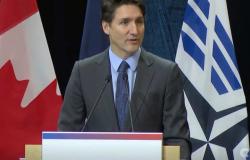Economists polled by Reuters expect the consumer price index to stand at 1.9% for the month of October, compared to 1.6% in September, the rate of lowest inflation since February 2021.
Gasoline prices were a key reason why September’s reading was so low, with oil falling to a level of around $65 a barrel at one point. It is also expected to be one of the drivers of the increase in October, when it reached $75 per barrel.
“We expect headline inflation to rise to two percent, but just as it has fallen to 1.6 percent, it’s mostly about energy,” said Claire Fan, an economist at RBC .
The expected increase in inflation is partly based on changes in last year’s baseline and should not be seen as an abandonment of progress made in bringing down the measure, she said.
“The overall story is that this low inflation, or this inflationary pressure that is gradually easing, very much remains the trend.”
– Claire Fan, economist at RBC
Excluding volatile energy and food measures – which Ms Fan said are expected to remain stable at 2.8 percent – core inflation is expected to fall to 2.2 percent in October, compared to 2.4 percent in September, she added.
BMO Capital Markets forecasts headline inflation of 1.9 percent and core inflation of 2.4 or 2.5 percent, Benjamin Reitzes, managing director of Canadian rates and macroeconomic strategist, said in a note.
“The month of October seems to be a bump in the road for the downward trend in inflation. Prices haven’t really risen over the month, but base effects are challenging, suggesting that both headline and core inflation will accelerate modestly.”
Besides a slight increase in gas prices, he expects rising property taxes to be a key factor in the increase. The tax increase will help drive up housing costs, but it will be offset by a smaller increase in mortgage interest costs after the Bank of Canada cut interest rates again in October.
High mortgage payments due to interest rates and a wave of mortgage renewals have put upward pressure on housing inflation, but the downward trend in rates should begin to ease pressure on the housing inflation, Mr. Fan said.
“Month to month, I think we are very close to an inflection point.”
The Bank of Canada lowered its key rate by half a percentage point in October, to 3.75%, the fourth reduction since June.
Inflation still high on the rent side
On the rent side, Maëlle Boulais-Préseault, economist at Desjardins, said in a note last week that rent inflation averaged 8.3% in the third quarter, the highest rate since the 1980s.
This contrasts with growth in owner-occupied housing prices, which slowed to 5.5% as borrowing costs continued to fall, she said.
Rent inflation, which aims to measure what Canadians actually pay in rent rather than the cost of new rentals, is expected to decline, but not quickly.
“We expect the pace of rent inflation to slow over the coming years, alongside the increase in the unemployment rate and the slowdown in population growth,” said Ms. Boulais-Préseault.
The slowdown in the labor market should also help reduce pressure on inflation, Fan said.
This contrasts with the United States, where inflation rose 2.6% in October from a year earlier, up from 2.4% in September, as increased government spending and a strong financial market work make reducing inflation a challenge.
The two countries diverge on a range of key economic measures, including real GDP per capita which is the widest gap on record, Fan said. In Canada, this measure is 3% lower than it was in 2019, while it is 8% higher in the United States.
As the two economies diverge, the Canadian dollar has come under pressure, trading at lows not seen since 2020.
The weakening loonie, a possible upward revision of GDP and the slight increase in inflation in October lead Mr. Reitzes of BMO to expect that the Bank of Canada will opt for a more moderate reduction of one quarter of a percentage point of its key rate at its meeting on December 11.
RBC, however, expects another half-point cut from the central bank, given the struggling economy and the time it takes for rates to have an effect.
“Given the current weak conditions and the fact that even if we cut rates today, it will not have an effect for at least two quarters, the central bank really wants to anticipate any easing measures “, continued Mr. Fan.
“If they think the economy needs to be supported, they want to do it as quickly as possible.”






